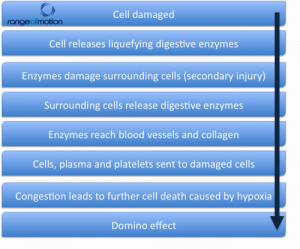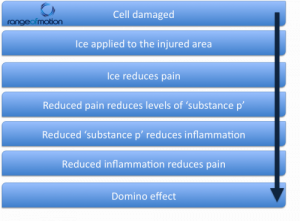It’s beginnings are all too familiar. An ankle rolls. A knee gives way. An muscle starts to hurt when it shouldn’t. Welcome to inflammation. For the sake of this post, we discuss the inflammation caused by injury or trauma (mechanical inflammation). Inflammation can also be chemical (stings or poison), thermal (heat or cold), microbiological (virus, infection or parasites) or immunological.
There are four cardinal signs of inflammation, each with specific physiological causes:
Heat (calour):
Caused by:
- Increased blood flow.
- Increased cellular metabolism.
Redness (rubor):
Caused by:
- Increased blood flow.
- Increased fuid permeability
Swelling (tumor):
Caused by:
- Vasodilation (blood vessels opening up).
- Increased fluid permeability.
- Cellular influx.
Pain (dolor):
Caused by:
- Release of soluble mediators.
- Increased fluid permeability.
- Cellular influx.
The progression of events following damage to the cell reads like a game of dominos.

What we have here is an ‘overallocation of resources’. Imagine a ‘mini’ breaks down on a major highway. This on it’s own is not a major issue. The problem is localised to the driver of that car and the influence is minimal. What happens next changes all that. Every tow-truck in town wants the business. They flock to the scene, congesting the road and causing major traffic jams. The more cars become involved, the more cars are influenced. This overallocation of resources is the same as that seen during the process of inflammation. What we need is a chopper to airlift that broken down mini out of there.
The correct allocation of resources is important – in fact vital – for healing. What we want to do is to stop the overallocation that results in serious inflammatory processes.
One of the most effective methods lies in icing the affected area. Pain (which you will remember is one of the four characteristics of inflammation) releases a nasty chemical called ‘substance p’. This causes positive inflammation feedback, that is, it causes more inflammation. The effects of ice change the immediate domino effect

In severe cases, inflammation can become severe, called ‘chronic inflammation’. This is when the signs of inflammation persist for longer that four to six weeks. This is one of these conditions that ice could have had fixed in two days, but instead becomes a major disabler. From a mechanical perspective, the major cause of chronic inflammation is irritation and interference with repair. So rest! Swallow your pride and think long term.




